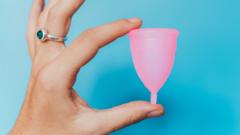In a cautionary tale, doctors are alerting women to the potential risks of misusing menstrual cups after a patient developed temporary kidney problems due to incorrect placement. The incident involved a woman in her 30s who had been experiencing intermittent pelvic pain and visible blood in her urine for several months, oblivious to the fact that her menstrual cup was the culprit. This case, reported by Danish health professionals in the British Medical Journal, underscores the importance of correct usage of menstrual cups, which serve as eco-friendly alternatives to traditional sanitary products.
Menstrual cups, made from soft and flexible silicone or rubber, can collect up to 30ml of menstrual blood, being reusable and sustainable options. They must be properly sized and placed to prevent any pressure on nearby organs such as ureters, which carry urine to the bladder. Although kidney complications from menstrual cups are rare, medical experts emphasize that the correct cup size, shape, and technique in insertion are necessary to mitigate risks.
Dr. Kate Lough, a physiotherapist specializing in pelvic health, notes that learning to use a menstrual cup can be a challenge for first-time users, particularly when it comes to removal. To successfully remove the cup, she advises against simply pulling on the stem; instead, users should gently squeeze the base to release the suction seal, which can often be a learning curve. A recent survey found that many young users struggled with their first attempt at removal and some even sought assistance.
Moreover, variations in cup size, shape, and firmness exist to cater to individual needs, particularly for younger users and those who have never given birth. Even individuals with recently inserted contraceptive coils must take extra precautions, as the suction can unintentionally dislodge the device. In the event that the threads of a coil cannot be located, the manufacturer advises consulting a healthcare professional for guidance.
Similar to menstrual cups, menstrual discs are another alternative designed to be placed higher in the vaginal canal, just below the cervix. As menstrual products continue to adapt and gain popularity, awareness of proper usage and the importance of individualized fitting remains crucial in safeguarding women’s health.



















